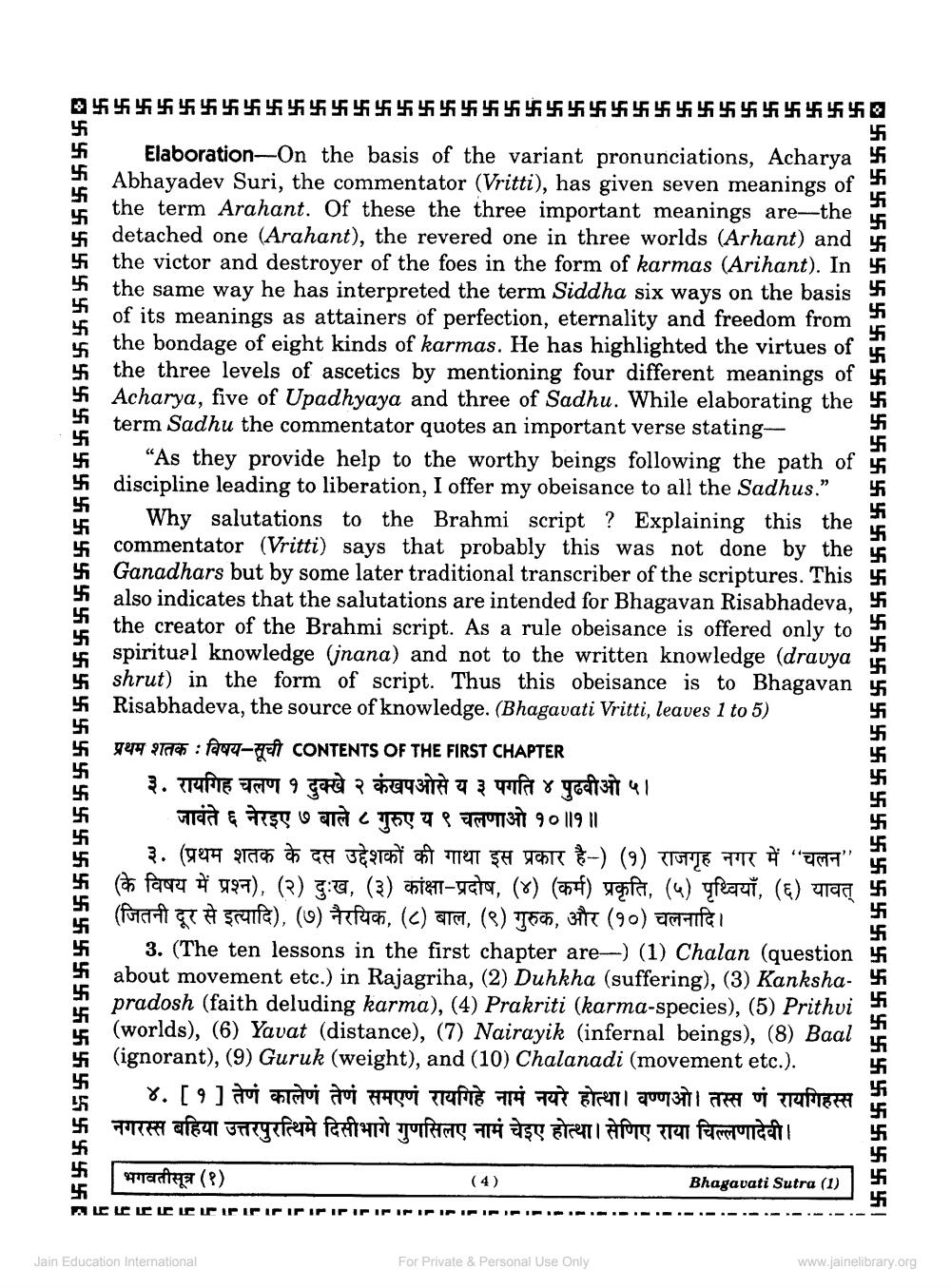________________
2 454 455 456 457 4141414141414141414141456 457 41 41 41 41 41 41 41 41 41 41 41 41 41 41 41 41 41 41
Elaboration-On the basis of the variant pronunciations, Acharya Abhayadev Suri, the commentator (Vritti), has given seven meanings of the term Arahant. Of these the three important meanings are the detached one (Arahant), the revered one in three worlds (Arhant) and the victor and destroyer of the foes in the form of karmas (Arihant). In 41 the same way he has interpreted the term Siddha six ways on the basis of its meanings as attainers of perfection, eternality and freedom from the bondage of eight kinds of karmas. He has highlighted the virtues of the three levels of ascetics by mentioning four different meanings of 4 Acharya, five of Upadhyaya and three of Sadhu. While elaborating the term Sadhu the commentator quotes an important verse stating
"As they provide help to the worthy beings following the path of discipline leading to liberation, I offer my obeisance to all the Sadhus.”
Why salutations to the Brahmi script ? Explaining this the commentator (Vritti) says that probably this was not done by the Ganadhars but by some later traditional transcriber of the scriptures. This also indicates that the salutations are intended for Bhagavan Risabhadeva, the creator of the Brahmi script. As a rule obeisance is offered only to spiritual knowledge (jnana) and not to the written knowledge (dravya shrut) in the form of script. Thus this obeisance is to Bhagavan Risabhadeva, the source of knowledge. (Bhagavati Vritti, leaves 1 to 5)
454 455 456 457 41 41 41 41 45 45 $454545
4454557441 44 45 46 47 455454545454545454545454545454545454545454545454545454 455 456 457 454 455 456 45%
894 94 : faqa- CONTENTS OF THE FIRST CHAPTER ३. रायगिह चलण १ दुक्खे २ कंखपओसे य ३ पगति ४ पुढवीओ ५ ।
जावंते ६ नेरइए ७ बाले ८ गुरुए य ९ चलणाओ १०॥१॥ 3. (9977 grach To GH BEITOST at T H YOU :-) (9) TTTLE FR # 26" as face # 497), () giu, (3) IT-yeta, () (f) uofa, (4) yfecut, () yra (Furni srilfe), (9) #puch, (c) arc, () T505, 3112 (90) m ai
3. (The ten lessons in the first chapter are ) (1) Chalan (question si about movement etc.) in Rajagriha, (2) Duhkha (suffering), (3) Kankshapradosh (faith deluding karma), (4) Prakriti (karma-species), (5) Prithvi (worlds), (6) Yavat (distance), (7) Nairayik (infernal beings), (8) Baal (ignorant), (9) Guruk (weight), and (10) Chalanadi (movement etc.).
४. [१] तेणं कालेणं तेणं समएणं रायगिहे नामं नयरे होत्था। वण्णओ। तस्स णं रायगिहस्स नगरस्स बहिया उत्तरपुरथिमे दिसीभागे गुणसिलए नामं चेइए होत्था। सेणिए राया चिल्लणादेवी।
144445464564545454545454545454545454545454545454545454 455 456 457
wetET (?)
(4)
Bhagavati Sutra (1)
A
ucruriririririririr IPIRIPIRIPIRIPIRI
Jain Education International
For Private & Personal Use Only
www.jainelibrary.org




